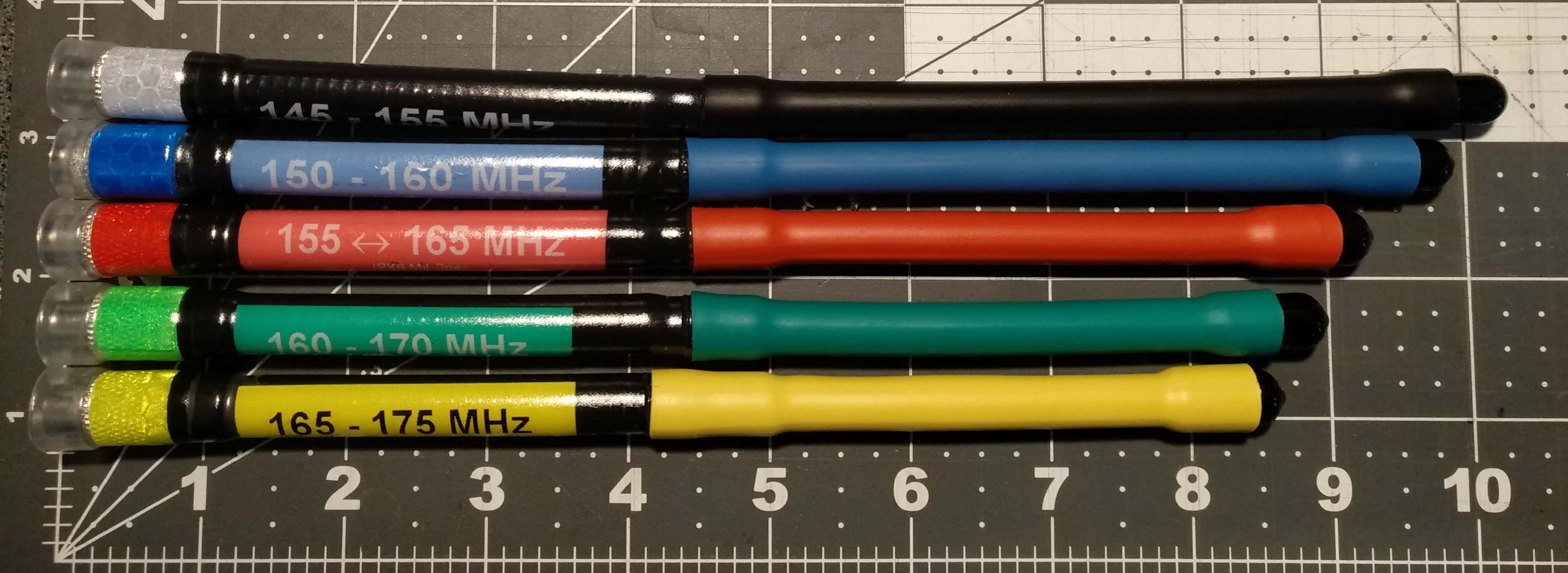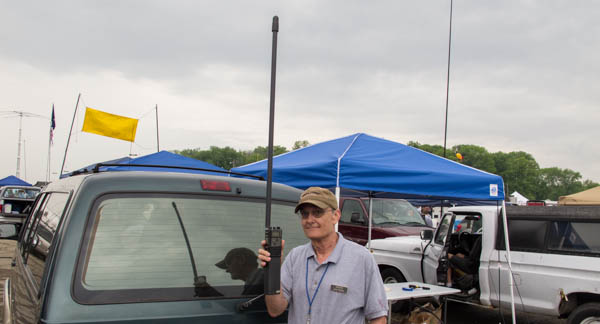Purpose-Built, SAR Antennas for handheld radios:
OEM SMiley Antennas:
◘5/8 Wave SAR Rubber Ducks:
◘1/4 wave UHF Duck antenna for FRS channels:
◘ 5/8 wave UHF/1/4 wave VHF, dual band telescoping
◘5/8 wave VHF telescoping (tunable to range of 145-175 mHz) antenna:
Aftermarket value-aded antennas
◘Counterpoise, also called: Rat Tail
◘*Big Three IPX6 antenna pack (3 pcs of above 5/8 SAR Duckies):
Color coded to match frequency range, and frequency range printed on the bottom section as well. Built on the core of the above 5/8 wave SAR ducks. These are reinforced military grade, designed and used by US Marine Core.
More details on this line here.

You will often hear someone mention that such and such a model or brand of radio performs much better than some other model or brand. What they usually do not realize is when they are quoting the radio that had the best performance, they are probably referring to the radio that had the best antenna that matched the frequency they were on, and offered the most 'Gain'. With HT's, generally the make and model of the radio mean nothing when it comes to how far you can transmit, and the antenna is *EVERYTHING*. This is not some shill to sell you more antennas and make more money from you. The stock antenna that comes with any of the retail handheld radios in testing generally exceeds an acceptable SWR ratio outside of the 145-155 MHz transmit window (at the standard ACMG frequencies it has an SWR of 3:1 and robs the equivalent of 3.5 watts of your available Tx power). Even then the gain can't come close to what is available with purpose built antennas. In fact, the antennas that come with most HT's are simply dummy loads that actually give you NEGATIVE gain! Because we deal with specialists who make their living with this equipment, we stock the specific antennas that we offer because our client base are not buying radios to find Mary when she disappears in the Mall, or co-ordinate a Coffee Clatch at Tim Horton's with their local HAM buddies. So much so, we will not program any radio with a frequency unless the proper antenna to match that frequency has also been ordered.
Here is an anaology to answer why we will not program frequencies into a radio that has not ordered the proper antennas to match those frequencies. Let's imagine I run a car lot that sells new BMW's. You come to my lot, and decide to buy a new BMW. I give you a choice, you can save a lot of money if I give you the car with one standard OEM wheel, and 3 "run-flats" on it. As your cash is tight at the moment, you decide to see how the car will go with run-flats temporarily until you have more money, when you will buy the proper wheels. I warn you not to drive the car at highway speeds while you have the run-flats on it. You get home, and the first thing, your teenage son wants to take the car out for a spin. He thinks it's going OK, so he takes it up to highway speeds, has a blow-out, crashes through the barrier, and damages the car. Well, using a radio with an antenna that should not be on the radio for a given frequency is the same as using a car with a wheel that is not meant for a given speed, both results can end up not only damaging the item (via a standing wave in the case of the radio), but present a safety hazard for the operator and his companions (EG: not being able to summon help in the case of the radio). I would have a very dim view of a car dealer that offered to sell me a new car with only run-flat wheels on it. The stock OEM dual band antennas that come with all handheld radios are the equivalent of run-flat tires - it is only safe to use it for a very narrow window of operating parameters. What you do with your radio once you own it is entirely your business, however just as it would be for a BMW dealer to let you leave the lot in your new car with run-flat tires on it, it would be negligent of us to supply a radio with frequencies that can cover a span of 30mHz with a stock antenna that can only cover 5mHz of that span, and even that 5mHz window only allows for not damaging the radio, it does not even come close to providing the maximum transmit range.
Our 5/8 wave rubber duck antennas are made for us in the USA and are specifically designed and intended for Search and Rescue work. Why 5/8 wave, what's wrong with the 1/4 wave stock antennas? It's because in our case, we work in backcountry situations where we are aiming our radio waves at the horizon, or 'near horizon' distant repeaters. In fact if you are working with a helicopter, or a repeater that is situated at a sharp angle above you, then 1/4 wave is better because your signal propagates upward at a steeper angle from a 1/4 wave antenna that a 5/8 wave. You must read this to understand why you MUST use these antennas. They also allow for the use of a 'Rattail' which again notably increases your transmit range because you are rarely going to be providing a decent ground plane. Standalone, these antennas give 3 to 7 dB gain and have less than 1:3 standing wave ratio. This means it is the most suitable rubber duck style antenna to use for mountaineering (also see the telescoping antenna to determine your best choice). Each rubber duck 5/8 wave antenna will cover a 10MHz window of transmit range, and the one Rattail will work with all of them. For example if you were travelling a logging road to go climbing near a CHM lodge, you would need one antenna to talk to the logging trucks on 155MHz, and another antenna to talk to the Lodge on 173MHz. (See below for more information as to why more than one antenna may be necessary). The simple helical spring on rubber duck style antennas is intended to withstand rough handling, but is not indestructible. Recent studies completed by the US Gov't found that 60% of tested rubber ducks used by firefighters failed, and needed to be replaced when they came off the fire line. That is why we have also designed and manufacture our IPX line of heavy duty antennas. The California ACS recommends that flexible antennas be replaced annually or more often if they show any apparent kinks, abrasion or other wear to visual inspection.
Cut-Away View of our Helical Elements Construction

- A: Exterior PVC or TA exclusive MPQ2000 special space age covering provides the most rugged yet flexible HT antenna available today.
- B: A synthetic rubber dip provides a weather seal, as well as a dielectric constant and a mechanical web effect between the coils of the spring preventing any distortion of the coil. When heated it bonds to the outer covering.
- C: Highly efficient copper plated radiating elements are used to maximize power to communicate, unlike un-plated elements that have high resistance to RF energy and cause dielectric losses.
- D: Tuned Antenna bases are all flow soldered, assuring excellent electrical connection, plus double protection at the point of maximum stress. The universal bases are all nickel plated brass, not steel, preventing dissimilar metal oxidation or rust. Our antenna bases accept 14 different connectors: BNC,TNC, etc.
- E: A Black Delron insulator is used for extra strength in all BNC, TNC, Kenwood connectors, as well as GE-PE, MPR and Repco adapters.
- F: A solid machined brass pin is used in all our connectors for extra strength and attaches through the insulator to the base of the antenna, making a positive electrical connection, as well as a mechanical connection.
Note: Chinese radios such as the Wouxun, Anytone, and Baofeng's have a different gender mount than Yaesu, etc. The antennas we sell are a proper fit for the radio you are buying. This eliminates the need to purchase a gender changer to enable you to be able to mount an antenna intended for North American/Japanese radios which then changes the gain of your antenna and creates a standing wave. A standing wave is undesirable in that will decrease your transmit power (and thus range), and it also degrades the components in your radio that will cause it to fail over time. These antennas average 24cm in length.
Q: Why do you say that it is not possible to make a broadband antenna that covers 144-174?
A: Rubber ducks are 'resonant antennas'. Making an antenna resonant is one way of tuning out the reactive components (inductance or capacitance) and is why loading coils are used in short whips for example, which are electrically very short and so have a significant capacitive reactance component. The problem with resonant antennas is that as they use the antenna's self inductance and capacitance for resonance - this is true at only one frequency - and unless it is a very lossy antenna, will rapidly leave resonance when tuning high or low. In many cases, the application of broadbanding techniques is more about adding loss in the antenna to reduce Q which in turn flattens the tuned circuit skirts, hardly an efficient system.
To get pricing, or to purchase antennas please submit an order form (click here for link), and we'll send you an invoice and payment instructions.

